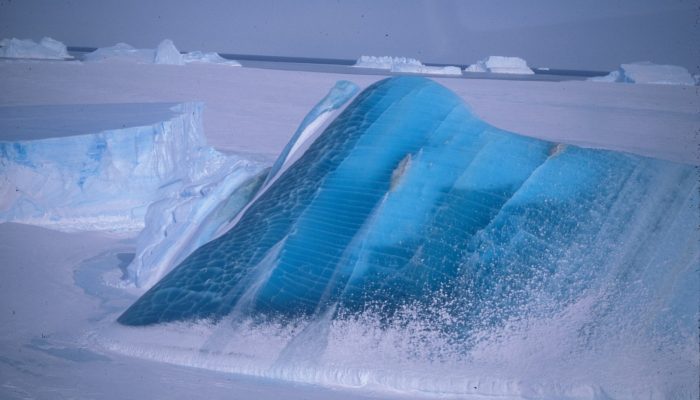
It is Easter weekend! And as we do not want you to forget about our beloved cryosphere, we provide you with a picture nearly as colourful as the Easter eggs: very blue icebergs! What makes them so special? This is what this Image of the Week is about…
What are icebergs made of?
Icebergs are chunks of ice which break off from land ice, such as glaciers or ice sheets (as you’ll know if you remember our previous post on icebergs). This means that they are mostly made up of glacial ice, which is frozen freshwater from accumulated snowfall. However, in some places where ice sheets extend to the coastline, making an ice shelf, icebergs can be made up of a different type of ice too.
Ice shelves can descend far down into the ocean. Seawater in contact with the ice at depth in the ocean is cooled to the freezing temperature. Because the freezing temperature decreases with decreasing pressure, if the seawater moves upwards in the ocean, it will have a temperature lower than the freezing temperature at that depth. That means it’s super-cooled – the seawater temperature is below the freezing temperature, but it hasn’t become a solid. The seawater cannot last for long in this state and freezes to the base of ice shelves as marine ice, which is seawater frozen at depth. The marine ice can help stabilize the ice shelf as it is less susceptible to fractures than glacial ice. Icebergs that calve from Antarctic ice shelves can sometimes be mixtures of glacial ice (on the top) and marine ice (on the bottom).
What can icebergs tell us?
Icebergs which tip over can tell us about processes that happen at the base of ice shelves. For example, scallops on the ice (the small indentations that can be seen in the second picture) can show the size of turbulent ocean eddies in the ocean at the ice shelf base. Basal cavities or channels show where oceanic melt had a large impact. Any colours visible in the iceberg can also give us information.
Why are icebergs different colours?
Like snow (see this previous post), different types of ice appear different colours. A typical iceberg is white because it is covered with dense snow, and snowflakes reflect all wavelengths of ice equally. The albedo of snow, which is the proportion of the incident light or radiation that is reflected by a surface, is very high (nearly 1). Glacial ice is compressed snow, meaning it has fewer light-scattering air bubbles, so light can penetrate deeper than in snow, and more yellows and reds from the visible spectrum are absorbed. This results in a bubbly blue colour, with a slightly lower albedo than snow. Marine ice does not have bubbles, but light can be scattered by cracks, resulting in clear blue ice (see our Image of the Week). However, if the seawater from which the marine ice was formed contained organic matter, like algae and plankton, the resulting marine ice can have a yellowish or even green appearance (Fig. 3). If the marine ice formed near the base of an ice shelf where it meets the sea floor, it could contain sediment, giving it a dirty or black appearance.
So the colour of icebergs can tell us something about how ice was formed hundreds of metres below the ocean surface. You could even say that was super-cool…
Further reading
- Warren, S. G., C. S. Roesler, V. I. Morgan, R. E. Brandt, I. D. Goodwin, and I. Allison (1993), Green icebergs formed by freezing of organic-rich seawater to the base of Antarctic ice shelves, J. Geophys. Res., 98(C4), 6921–6928, doi:10.1029/92JC02751.
- Morozov, E.G., Marchenko, A.V. & Fomin, Y.V. Izv. (2015): Supercooled water near the Glacier front in Spitsbergen, Atmos. Ocean. Phys. 51(2), 203-207. https://doi.org/10.1134/S0001433815020115
- Image of the Week – Ice Ice Bergy
- Image of the Week – Fifty shades of snow
This post is based on a talk by Stephen Warren presented at AMOS-ICSHMO2018
Edited by Clara Burgard
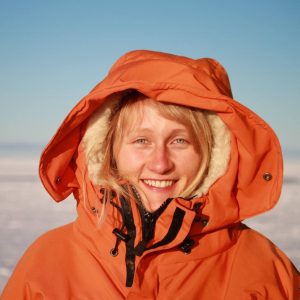 Lettie Roach is a PhD student at Victoria University of Wellington and the National Institute for Water and Atmospheric Research in New Zealand. Her project is on the representation of sea ice in large-scale models, including model development, model-observation comparisons and observation of small-scale sea ice processes.
Lettie Roach is a PhD student at Victoria University of Wellington and the National Institute for Water and Atmospheric Research in New Zealand. Her project is on the representation of sea ice in large-scale models, including model development, model-observation comparisons and observation of small-scale sea ice processes.

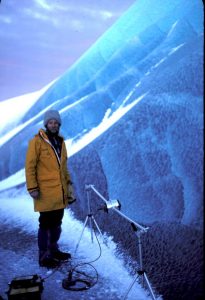
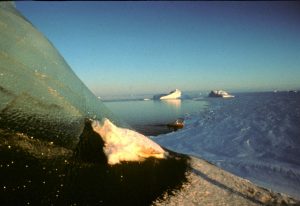
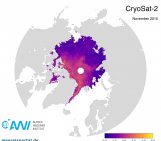
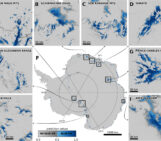
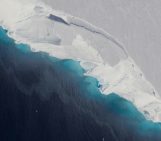
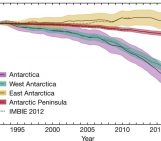
Yusup
The reason for the formation of hydrogen sulfide in the Black Sea.
The wind waves enrich the water with oxygen only to a depth of several tens of meters of the seas and oceans surface, while the whirlpools deliver the water enriched with oxygen to a depth of more than 10 km. (Mariana Trench)
How does this happen:
The waters of the lakes, seas and oceans of the northern hemisphere rotate counterclockwise, and the waters of the southern hemisphere rotate clockwise, forming giant whirlpools. https://en.m.wikipedia.org/wiki/Ocean_gyre
As is known, everything that rotates, including whirlpools, has the property of a gyroscope (whirligig) to maintain the vertical position of the axis in space, regardless of the rotation of the Earth.
If you look at the Earth from the side of the Sun, the whirlpools, rotating with the Earth, overturn, due to which the whirlpools precess, resulting in a vertical movement of ocean water. http://goo.gl/AM5g1s
The presented theory can easily be verified by relation between the oxygen content and the whirlpools rotation speed.
Based on the map of the depths and currents of the seas and oceans.
The higher the current velocity, the greater the oxygen content and the lower the hydrogen sulfide content. https://youtu.be/ihM1I5r_MUg https://youtu.be/X6PavdKXIE8
List of seas with low oxygen content:
Black Sea. East of the Mediterranean. Gulf of Mexico. Norway fjords.
As we see, whirlpools are involved not only in the horizontal circulation of the sea and ocean waters, but also in the vertical. https://en.m.wikipedia.org/wiki/Dead_zone_(ecology) https://www.scientificamerican.com/article/ocean-dead-zones/
The coefficient of oxygen content can be expressed mathematically by the following formula O = V / G
V – whirlpool rotation speed, km / h.
G – depth of the reservoir, km.
Black Sea 0.2 / 1200 = 0.00016
Sea of Okhotsk 1/800 = 0.0012
Vertical movement of ocean waters can be convincingly modeled using simple experience.
For this, a half-filled vessel with a rotating liquid (bucket, tumbler, mixer) must be rotated around itself (in orbit).
If the liquid in the bucket rotates to the right, the bucket around itself (in orbit) must be rotated to the left.
Continued. Forum. National Research Nuclear University MEPhI https://mephi.ru/communication/forum/talk/forum13/topic5498/messages/
Forum Federal Target Program “World Ocean” http://okeany.com/forum/570.htm
Cambridge University Forum https://www.thenakedscientists.com/forum/index.php?topic=73127.0